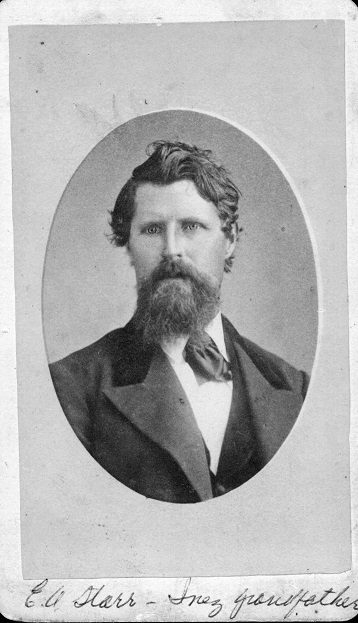As printed in
The Blue Mountain Eagle Newspaper, April 7, 1922
Indians, Shoot Outs, and Horse Racing.
According to promise I will try to give you a few more of the happenings of the pioneer days of long ago. This is only as I remember them. By taking more time I might be able to make it more picturesque, yet I only try to give the facts as near as I know how and to make it plain to the readers, provided it is worth reading.
This account was along in 1863 before I came to Canyon City. It is an account of a battle the miners had with a few Indians on the headwaters of Big Pine Creek, who had sneaked in and stolen a few head of the miners horses near Prairie Diggins. A few miners went in pursuit. After overtaking the Indians had quite a little battle, killing one Indian and wounding another which they captured the next day. He had one leg shattered pretty bad. He hid in a bunch of brush and fought until he had exhausted all his arrows. They then captured him and brought him to Canyon City where the miners took a meat saw and cut his leg off, and he got well, stayed in Canyon City all winter and was kept by the miners. In the spring he skipped out for the Malhuer country and was never heard of anymore. He couldn’t talk or wouldn’t. The miners used to try to get him to talk but all they could get out of him was just try to repeat after them what they said.
At another time there were two desperados rode into Canyon City and told who they were. After getting tobacco and all ammunition they wanted they defied capture and rode away unmolested.
At another time before a road was made up Canyon Creek from John Day, there was just a trail between the two places. One night a man was going from John Day to Canyon City after dark and he had six twenty dollar gold pieces in his pocket, and being afraid he would meet a holdup man, he placed three of the twenty dollar gold pieces from his pocket and held them in each hand. And sure enough, he soon saw a man step out of the brush and ordered him to throw up his hands, to which he complied, keeping the three twenties in each hand. He held his hands straight over his head and the highway man, after searching him and taking $1.75 in silver he had in his pockets, told him to go on his way and not look back. So he did and saved the six twenties that he held in his hands. Those days a man never knew when or what he was running up against.
While A.E. Starr was in Canyon one night having a good time dancing with the hurdy-gurdies until about 3 A.M. in the morning, he started home and just as he got nearly on top of the hill between Marysville and Canyon City, two men stepped out and told him to throw up his hands. Instead of doing so, he pulled a big six-shooter and sent to shooting. He killed one of them and wounded the other, but he got away. Everybody packed a gun those days. Starr went back to town and reported what happened and gave himself up. The miners called a meeting, he was tried and exonerated. As it was whenever two or more men got into a dispute, the miners called a meeting and appointed two good men to hear the case and they would decide which was right and which was wrong and that was to be final. There were no lawyers or judges or jurors. At that time the people were mostly law abiding citizens and got along far better under the old laws than they do now under so many new and complicated laws that a Philadelphia lawyer himself don’t understand.
As I said before there were but a few buildings in Canyon City, mostly tents, but it soon grew as another sawmill was erected by Alec McKenna up on Big Pine Creek. This was the second saw mill built in the county. Everybody was then supplied with lumber.
The main business in town was down on the lower street those days. There is where Kane shot and killed a man by the name of Watson for greenbacking him. Kane had loaned Watson $200.00 in gold and green backs were only worth 75 cents on a dollar those days, but you could pay back a debt off at their face. So Watson paid Kane in green backs after Kane had told him if he did he would kill him. So Kane got his six shooter and going down the lower street met Watson on the sidewalk. Kane pulled his gun and shot Watson six times to be sure he was dead. Kane was caught and tried by the miners and sentenced to be hung. In a few days a scaffold was erected up on the north side of the Cemetery. A company of soldiers was there from Camp Watson. They said when they were taking Kane up to the gallows some of the men were trying to get ahead when Kane said, “Boys, don’t be in a hurry as there won’t be any fun until I get there.” I saw him on the scaffold and the black cap put over his head and the rope around his neck and heard him say he wasn’t sorry for what he had done and if it were to do over he would do the same thing. The trap door was then sprung and he was dangling in the air below. I saw him cut down. This was the first man I ever saw hung and the last one I ever want to see, as I can imagine I can see him dangling yet whenever I happen to think about it.
The winter of 1865 was a hard one and everything had to be brought in by pack train from the Dalles. Groceries went sky high and flour went up to 50 cents a lb. or $25.00 for 50 lb. sack. Some of the miners were almost ready to put on war paint when spring came and pack trains commenced coming from The Dalles, which had been blocked for some time. B.C. Trowbridge was the only man that was raising vegetables to sell those days that I remember. He can tell you better about that than I can. He had to climb up over that steep hill south of John Day on up that long ridge going from Canyon City out by Marysville past Prairie Diggins on up the river to Dixie Creek where Prairie City now stands.
Old man Ingles brought the first threshing machine into the John Day country.
The first mile track for racing was built on top of the hill west of Canyon Creek where George Gundlock later had a farm. They had a good many big races there and large purses were hung, which brought a great many good horses there to compete, mostly long distance horses. horses came from everywhere. I remember a few of them. Old Bucket from Willamette Valley was there with horses named Whale Bone, Old Doc Wilks and some more. Old Bingham from the Big Bend had Old Dock Lindsey and others. Baker City had a nice boy horse there, Dasher. Dasher and Old Doc Lindsey ran a single dash of a mile which was the prettiest and most exciting race that I ever witnessed. Johnny Austin rode Old Lindsey. They were both blood boys and looked just alike. They got on even start and when the drum tapped and they ran neck and neck all the way around and came under the wire at the judges stand with Doc Lindsey only winning by 18″. There was a lot of money changed hands on this race. There were some trotting races also.
The next mile track was built on the hill north of the McHaley farm near prairie City. The first race that took place was a match race $100.00 a side. Stay With Jack by Nick Thorton and an Indian horse from Umatilla ran. It was a single dash of a mile and was won by the Indian horse. The race was run on Christmas day and there was a foot of snow that fell the night before. The next mile race was built at Mt. Vernon where they held some good race meetings. I remember there is where I beat J.J. Cozarts blacksmith trotter stallion, 3-5 mile heats with Old Apple Jack, a Blue Mt. colt my father raised. Sproul afterwards bought him and took him to California and afterwards made the best half mile on record at that time. And here at the Mt. Vernon track was where Old Man Hamilton made a match race with a man from Heppner for a $1000.00 a side to run six hundred yards on a straight track six weeks later. Blue Mt. Bell by Hamilton against a mare named Premium. The race was won by Premium by about 6″. The owner of Premium bought Blue Mt. Bell after the race was run.
The next mile track was built on the Galbraith Ranch just west of Prairie City. Here they held a good many races. Hung some good horses. Horses came from everywhere. One 4th of July had one $1000.00 purse single dash of mile free for all. It was won by Blue Mt. Bell. After, a mile track was built across the river south of Prairie City, where the best races that were ever run in the county took place. They held the District Fair there for 3 years. Then the half mile track was built at John Day and the District Fair and race meetings held there ever since.
Now the next race track is on the old trail or wagon road leading from The Dalles to Canyon City – a distance of 200 miles. The Pony Express for a purse of $1000.00 to take place on June 8, 9, 10 to bring back a Remembrance of the Days of Old, and the days of Gold on Canyon Creek on the 2nd of June, 1862.
W. Ralph Fisk


